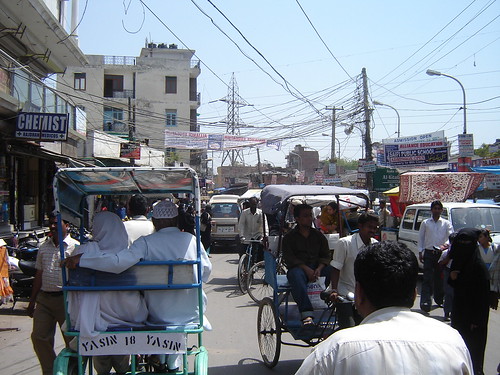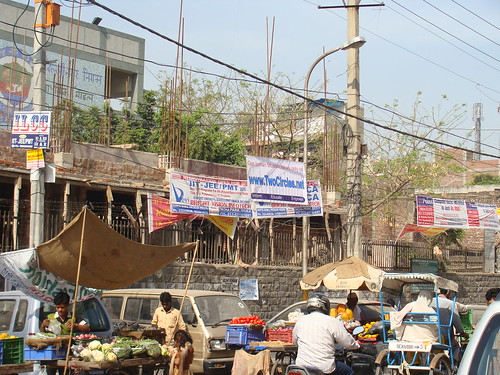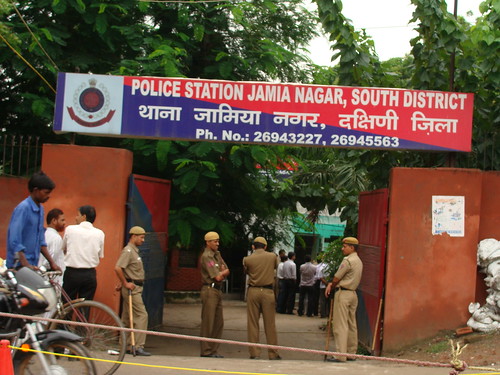By Ather Farouqui,
With the spectre of communalism raising its ugly head all across the country, Muslim ghettoization is emerging as a grave and complex problem that requires urgently to be addressed. It has a decisive bearing on communalism. Unfortunately, it has not drawn any serious attention.
It is common knowledge that during the last two decades, Muslim families have faced enormous difficulties in renting houses and flats in developed residential areas, which are obviously Hindu-dominated areas, as Hindu landlords tend to shun Muslim tenants even if they belong to the same social class and enjoy equal or better footing in society. In Bombay, for instance, a large majority of housing societies openly refuse membership to Muslims. In other cities, too, it is difficult for a Muslim to get an apartment in a housing society. Landlords and housing societies generally may not openly say no to Muslims but adopt various subterfuges. If a well-known Muslim cine artist in Bombay finds it difficult to rent a house from a Hindu landlord, the plight of the common Muslim as well as the gravity of the situation can be estimated.[1]

Muslim ghettoization began after partition but gathered pace with slow but steady migration of Muslims from rural to urban areas. Amongst other factors, the abolition of zamindari was a major factor for Muslim migration to urban areas as Muslims were the community most affected by the zamindari abolition. The second most important factor was the emerging insecurity as with the partition mass migration changed the sociology of demography. In the seventies and eighties it became a worrying phenomenon. Rural India is almost entirely bereft of Muslims except in Assam, Kerala and West Bengal. The villages of north India particularly, where Muslim presence was once 5-10 per cent, are now inhabited only by Hindus. The Muslim population has gradually been forced to migrate to Muslim localities in nearby towns. In all of north India, barring Jammu & Kashmir—which is itself a ghettoised Muslim society—it is difficult to find even a single Muslim family in Hindu-dominated areas even in towns and cities.
In general, Muslims are forced to settle in Muslim-majority areas with poor infrastructure and civic facilities, for which the government alone is to blame.

Until the early nineties, one could find Muslim government servants occupying government housing in areas where the majority of the population was not Muslim. But even here, a change has been visible since 1992. To take just one example: a large number of Muslim teachers of Jawaharlal Nehru University (JNU) in New Delhi, reputedly an enlightened institution with liberal outlook and social sensitivity, prefer to live in Muslim-dominated colonies or ghettos rather than on university campus after 1992.
The result of this phenomenon is that all over the country Muslim families are to be seen only in areas that can be termed as ‘Muslim clusters’. Muslim staff members as well as the old generation of teachers at JNU, have mostly returned to Muslim-dominated areas after retirement. An employee of the World Bank or a foreign mission, owing to fear psychosis, is often forced to live in places like the Jama Masjid area of Old Delhi, though his social profile certainly does not match that of the average inhabitant of the walled city. It has become common for families that moved from the walled city to New Delhi some fifty years ago to move back to their old family homes simply because they do not feel secure in Hindu-dominated areas.

Jamia Nagar, near New Friends Colony in south Delhi, boasts huge Muslim elite which shifted there after 1992. Land costs here have gone through the roof owing to limited space and tremendous demand as each new day brings more families, even NRIs, needless to say Muslim NRIs, seeking a safe foothold in Delhi further straining the already poor infrastructure. Such is the state of infrastructure here that Jamia Nagar, which adjoins the campus of theJamia Millia Islamia, a central university, does not even have a government dispensary or a branch of a public sector bank (though there is one on the university campus). Delhi Chief Minister Sheila Dikshit admitted the lack of these bare minimum facilities in the area in a TV interview after the Batla House shootout. The disturbing thing was that she had been unaware of the situation despite having been ten years at the helm of affairs in Delhi.
Jamia Nagar conjoins many Muslim colonies such as Batla House, Zakir Nagar, Abul Fazal Enclave, Ghaffar Manzil, Johri Farm, Noor Nagar, and Okhla Vihar. This whole area, with a population of about 10 lakh, is a victim of official apathy. The situation is not unique to Delhi but prevails in all state capitals and district towns.
No multinational bank provides the inhabitants of Muslim colonies with credit cards and MNC pizza and burger outlets, based in nearby posh areas refuse to deliver in these areas. The capital city of India, New Delhi, is no exception. Even housing loans are not extended by most nationalized banks in Muslim areas in Delhi and New Delhi, Jamia Nagar being just one example.
Who is responsible for this increasing ghettoisation of Muslims? Civil society is squarely to blame. Let me quote two instances which were widely reported at the time and still haunt the memory. The house of the famous Urdu poet Bashir Badr, who insisted on living in the Hindu-dominated colony of Shastri Nagar in Meerut because of his immense faith in secularism and popularity as poet amongst Hindus was lost to a communal blaze in the late 1987. Fortunately, the lives of his family members were saved as everyone was out at the time of the incident. Much worse was the assassination of Zaki Anwar, a college lecturer and Urdu writer, during the infamous Jamshedpur riots in 1979. Zaki had unshakeable faith in his Hindu neighbours, Hindu-Muslim unity, and Gandhian philosophy. He sat on a Gandhian-type long-drawn-out hunger strike in a Hindu-majority area to protest against communal tension. But all that his faith and his striving for togetherness and amity led to was his brutal killing. In both cases, it can be inferred that the Hindu neighbourhoods did not live up to the faith of the victims, whatever the reasons. Bashir Badr now lives in Bhopal and Zaki Anwar’s family in Jamshedpur, both in Muslim-dominated areas. One needs to study the case of Bashir Badr in perspective as he supported the BJP during NDA rule and is now a Muslim poster boy of the BJP in Madhya Pradesh. He made an all-India tour during the general elections of 2004 to convince Muslims to support the BJP and Atal Bihari Vajpayee as Prime Minster.

The poignant story of former Member of Parliament Ehsan Jafri, brutally murdered in a Hindu-dominated area in Ahmedabad in the 2002 Gujarat pogrom, is etched in the nation’s memory. No civil society can withstand repeated incidents of this kind.
The Bhagalpur riots of 1989 led to large-scale migration of rural Muslims in Bihar and the demolition of the Babri Masjid on 6 December 1992, and the resultant backlash drove the last nail in the coffin of Hindu-Muslim neighbourhoods all over the country. As per press reports on the Bhagalpur riots, in all the neighbouring villages of Bhagalpur, where Muslims constituted less than 10 per cent of the population, the majority were killed and only a few managed to flee. In Hashimpura locality of Meerut, 40 Muslim youths were taken away by the police in May 1987 and massacred in cold blood and their bodies thrown in the canal.
In sharp contrast, not a single incident has been reported of a non-Muslim, in particular a Hindu, family living in a Muslim-dominated area having faced a similar situation during communal tension or violence in India after independence.
All the same, post-1992 one can find hardly any Hindu family in a Muslim-majority locality, which was not the case earlier. Overall, the extremely surcharged atmosphere has forced non-Muslim families to shift out, turning their original abodes into Muslim ghettos by default. The phenomenon of a few Muslim families still living in Hindu dominated areas and vice versa needs serious sociological study.
The question is: does communal ghettoisation represent the death of our hitherto composite culture and liberal and tolerant outlook or can we still do something to save it? Do we have the option of remaining silent? The answer is decidedly no. The question then is: what can be done to set the clock back and foster communal harmony? It will take a lot of courage and determination to figure out the answers but that is the only way forward if secular democracy is to survive. And we have to do it before it is too late. A new and reformed politics shunning populism is a necessary step forward.
But we have to keep in mind that communal categorisation and communal identity perception can be resolved only through progressive mass movements dealing with issues pertaining to different facets of our shared life. Not for a moment does the term progressive refer to movement prescribed by different left wing political parties. The ideological confusion and resultant contradictions of these parties are more dangerous than the communalism. Movements for literacy, education, sports facilities, employment, health care, shelter, and community interaction can help develop a wider political and social consciousness, thereby lessening the communal identity perception of the common people.
This is also the only way forward if Indian democracy is to survive. And we have to do it before it is too late.
1. The shameful incident of Emran Hashmi, a noted film actor of Bombay, in July 2009 and a number of other incidents of the same nature in which high-profile Muslims were refused houses, highlight the problem. As per reports, Emran [Imran] Hashmi was ‘told by [the] Pali Hill’s Nibbana Cooperative Housing Society, [Bombay] to go and look elsewhere’. The actor, who is married to a Hindu girl, and interestingly whose mother is a Christian, ‘believes the housing society is discriminating against him because he is a Muslim’. He has further informed the media, ‘The seller, Survana, has now informed us that the society will not give us an NOC and it has blocked the sale. We have information that this has been done as they will not allow any Muslim in the society’.
It would be appropriate to remember that in the past, Bollywood actress Shabana Azmi, one-time Member of Parliament and her writer-activist husband Javed Akhtar, now a Member of Parliament, have faced problems getting a house in Juhu (Bombay). As per press reports appeared at the time of Emran Hashmi incident, we came to know that once actor Aamir Khan also filed a PIL after being refused a house in Lokhandwala, Maharashtra.
For a detailed report of the Emran Hashmi issue, see The Times of India, New Delhi, 31 July 2009 which published a news items entitled ‘ Emran Hashmi can’t get a house in Pali Hill’ on the front page with additional information entitled ‘Being a celeb does not mean you get everything’ on page 11.
—
A version of this article first appeared in the Times of India

